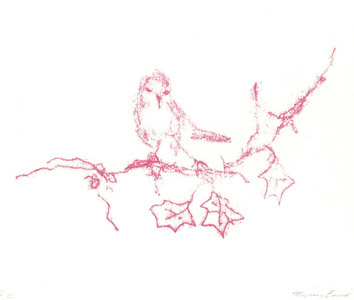Creating the Space
Art is not just a pleasing arrangement of shapes, textures and colours; it can only be properly appreciated in its cultural context. So-called ‘Conceptual’ artists use imagery to explores a theme that resonates with and provides insight into contemporary culture. In an age of internet dating and casual sex, Tracey Emin dares to explore female lust. Damien Hirst, on the other hand, expresses a more ordered corporate theme, in which feelings, emotions are put into boxes and bottles and categorised. But isn’t all art conceptual? Maybe historical notions of art were much more limited to religious imagery, myth, society portrait and landscape, but like classical musicians, each artist interpreted those concepts according to the fashion and spirit of the age. Likewise The Romantics, Turner’s misty decaying ruins alongside the engines of the industrial revolution, the pre-Raphaelite expression of the Victorian tension between spirituality and sexuality expressed the way the artist saw them as an instrument of the prevailing culture. But increasingly art has come to represent political and social themes. The Spanish artists, Picasso’s Guernica, Miro’s burnt canvases screamed their outrage at the horrors of the Spanish Civil War. Perhaps photojournalism occupies the same niche nowadays. One well constructed image is worth a thousand words.
So art changes as the social environment changes. But the artist also helps to create that environment by conceptualising aspects of culture in images and structures. So art is a medium to help people gain insight and understanding of their culture as expressed through the expressive perspective of one individual.
Of course, the creation of the artist says as much if not more about them as it does about the culture (though they are still a representative of the culture). Successful artists can be and often are self centred to the point of obsession; you might say they have to be. And in a narcissistic age, some art has self indulgent to the point of boredom. Do we really want to know so much about Tracey’s soiled bed, used condoms or how many men she fucked in her tent? Are we interested in the relationship with Louise Bourgeois’ father and her governess? In as much as it informs us about aspects of culture and psychology we are. Louis Bourgeois depicted a whole psychoanalysis in her art. Joseph Beuys went one stage further; he invented a fantastic personal narrative through his art; catapulted from his crippled Stuka when it crashed in deep snow in Crimea in 1944, he claims to have been rescued by Tartar tribesman, who kept him alive by wrapping his broken body in felt and animal fat and feeding him milk. His art reflects aspects of that incident as well the boundary between fantasy and reality.
Other artists use their experience to express something wider, more general, while maintaining the template of their formative life experience to fashion a recognisable identity-in-style. Henry Moore drew large female figures with holes in them to represent his fixation on the beloved, though at times distant mother; there were gaps in their relationship. .
Some artists are more blatently commercial in their adherence to culture; they generate shapes, ideas that people want. Anish Kapoor creates large reflecting surfaces, bulges, wax installations, that people enjoy. ‘Art is not meant to be controversial’, he recently declared. He likes to be liked.
Art doesn’t so much create the object, it creates the environment, the mental space through which the rest of us can think about their own existence. In doing so, it both represents the culture and helps to create it. The process can be transformative, but for some artists it can become iterative and hermetic, the unending scratching, etching of an itch until something changes to change the focus; war, famine, love.
Some art will travel; either because it expresses a universal theme, like love, or because its meaning is so meaningfully abstract, so that people from different cultures bring their own meaning to it. Shakespeare travels and so does Turner. Is this what makes art great? Is this the function of art; to create the space for the thoughts of others to enter. In our instant, media culture, people are often considered clever because they say what everybody else is thinking and wish they had said it. They re clever because they make everybody feel clever. Is that what artists do; set down a challenge that makes the rest of us feel clever by gaining insight? If so, they don’t necessarily do it deliberately.
‘They tell me it’s great art. To me, it was just another scribble’
It’s always good to talk to my brother; he is an artist and gets me to think out of the box!




Nick I really wish I could expressed what you have written as it has given me a lot to think about. For me art is difficult to understand and I need help by way of a cuartors lecture to help unlock the key so I can have some insight into what the artist is trying to convey.
How many people try to understand what the artist is saying? or perhaps thats not the point but rather how one reacts to it? Often it is at the level I like/dont like it and move on? It took me about 3 visits to YSP to have some understanding of that wonderful Jeume Plensa exhibition and my cousin’s 14 year old rather obessive daughter to say this is very clever! I started looking and learning then!